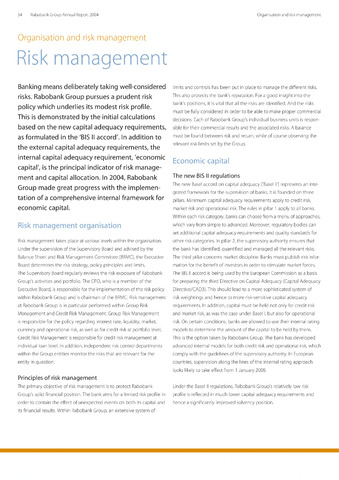Risk management
Organisation and risk management
Banking means deliberately taking well-considered
risks. Rabobank Group pursues a prudent risk
policy which underlies its modest risk profile.
This is demonstrated by the initial calculations
based on the new capital adequacy requirements,
as formulated in the 'BIS II accord'. In addition to
the external capital adequacy requirements, the
internal capital adequacy requirement, 'economic
capital', is the principal indicator of risk manage
ment and capital allocation. In 2004, Rabobank
Group made great progress with the implemen
tation of a comprehensive internal framework for
economic capital.
Risk management organisation
Economic capital
The new BIS II regulations
54 Rabobank Group Annual Report 2004
Organisation and risk management
Risk management takes place at various levels within the organisation.
Under the supervision of the Supervisory Board and advised by the
Balance Sheet and Risk Management Committee (BRMC), the Executive
Board determines the risk strategy, policy principles and limits.
The Supervisory Board regularly reviews the risk exposure of Rabobank
Group's activities and portfolio. The CFO, who is a member of the
Executive Board, is responsible for the implementation of the risk policy
within Rabobank Group and is chairman of the BRMC. Risk management
at Rabobank Group is in particular performed within Group Risk
Management and Credit Risk Management. Group Risk Management
is responsible for the policy regarding interest rate, liquidity, market,
currency and operational risk, as well as for credit risk at portfolio level.
Credit Risk Management is responsible for credit risk management at
individual loan level. In addition, independent risk control departments
within the Group entities monitor the risks that are relevant for the
entity in question.
Principles of risk management
The primary objective of risk management is to protect Rabobank
Group's solid financial position. The bank aims for a limited risk profile in
order to contain the effect of unexpected events on both its capital and
its financial results. Within Rabobank Group, an extensive system of
limits and controls has been put in place to manage the different risks.
This also protects the bank's reputation. For a good insight into the
bank's positions, it is vital that all the risks are identified. And the risks
must be fully considered in order to be able to make proper commercial
decisions. Each of Rabobank Group's individual business units is respon
sible for their commercial results and the associated risks. A balance
must be found between risk and return, while of course observing the
relevant risk limits set by the Group.
The new Basel accord on capital adequacy ('Basel II') represents an inte
grated framework for the supervision of banks. It is founded on three
pillars. Minimum capital adequacy requirements apply to credit risk,
market risk and operational risk. The rules in pillar 1 apply to all banks.
Within each risk category, banks can choose from a menu of approaches,
which vary from simple to advanced. Moreover, regulatory bodies can
set additional capital adequacy requirements and quality standards for
other risk categories. In pillar 2, the supervisory authority ensures that
the bank has identified, quantified and managed all the relevant risks.
The third pillar concerns market discipline. Banks must publish risk infor
mation for the benefit of investors in order to stimulate market forces.
The BIS II accord is being used by the European Commission as a basis
for preparing the third Directive on Capital Adequacy (Capital Adequacy
Directive/CAD3). This should lead to a more sophisticated system of
risk weightings and hence to more risk-sensitive capital adequacy
requirements. In addition, capital must be held not only for credit risk
and market risk, as was the case under Basel I, but also for operational
risk. On certain conditions, banks are allowed to use their internal rating
models to determine the amount of the capital to be held by them.
This is the option taken by Rabobank Group. The bank has developed
advanced internal models for both credit risk and operational risk, which
comply with the guidelines of the supervisory authority. In European
countries, supervision along the lines of the internal rating approach
looks likely to take effect from 1 January 2008.
Under the Basel II regulations, Rabobank Group's relatively low risk
profile is reflected in much lower capital adequacy requirements and
hence a significantly improved solvency position.

